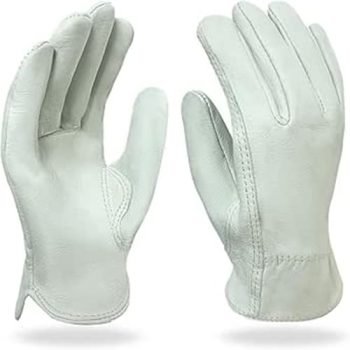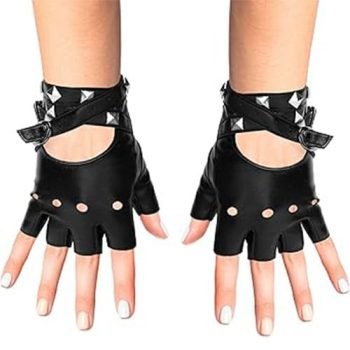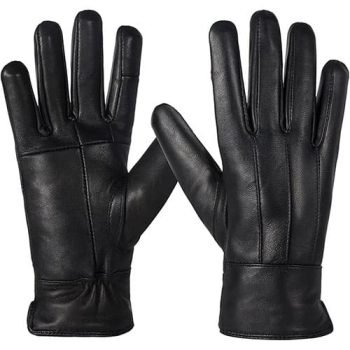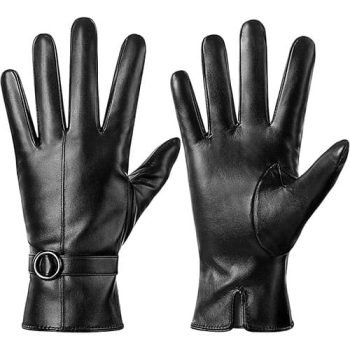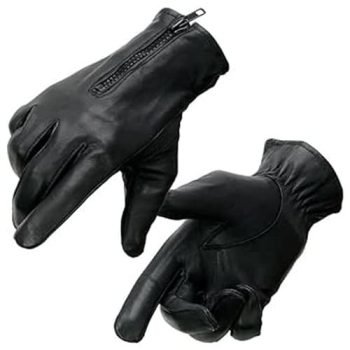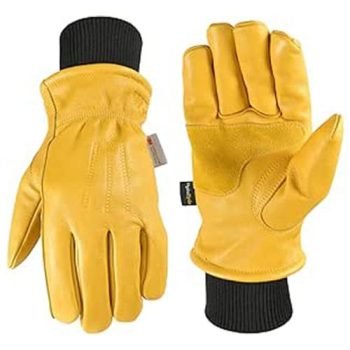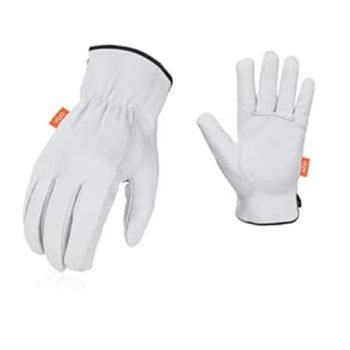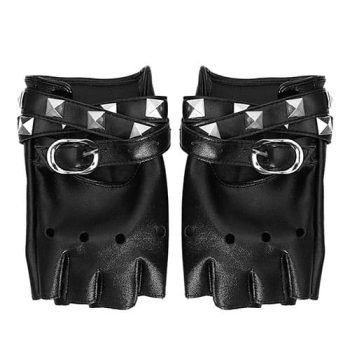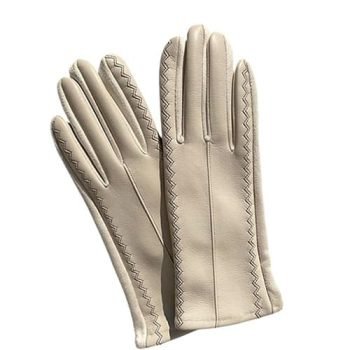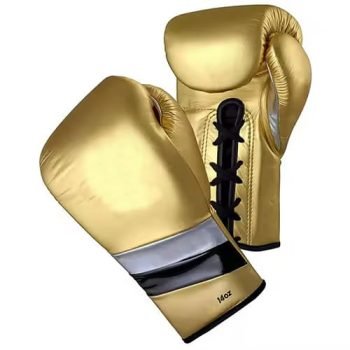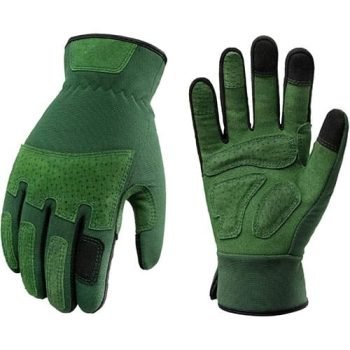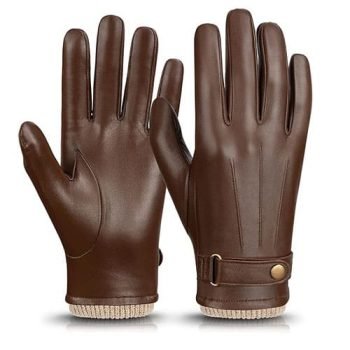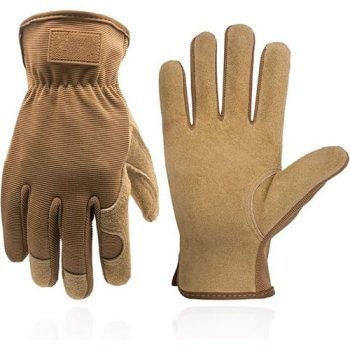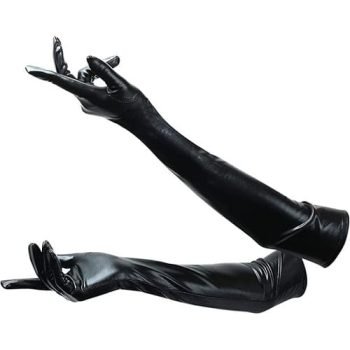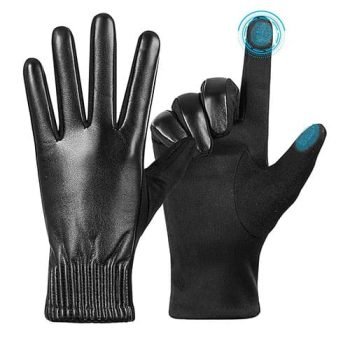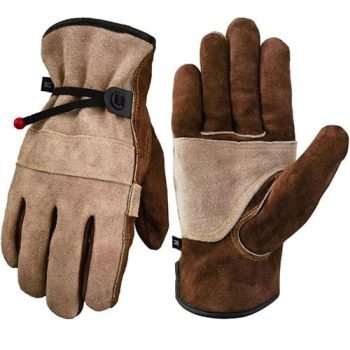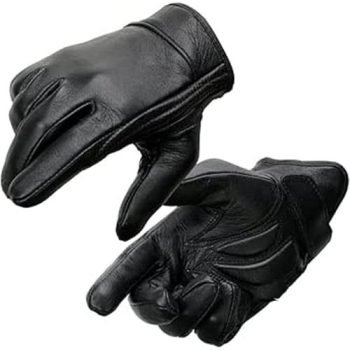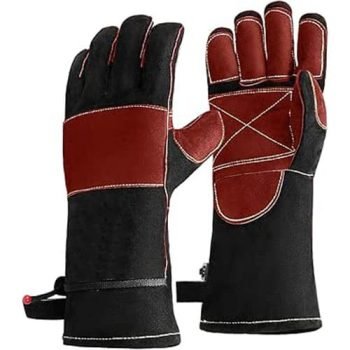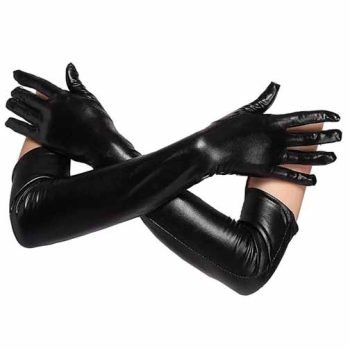Custom Leather Gloves Manufacturer
Szoneier Leather specializes in personalized leather gloves that combine comfort, durability, and style. From elegant dress gloves and insulated winter styles to riding, driving, and work gloves, we tailor each pair to your exact needs.
Available in full-grain, top-grain, or supple sheepskin leather, our gloves can be customized in size, lining (wool, fleece, cashmere), wrist closure, touchscreen functionality, and stitching detail. Branding options include embossed logos, metal snaps, or printed linings.
Whether you’re creating fashion-forward accessories or functional everyday essentials, Szoneier delivers gloves with expert craftsmanship and full OEM/ODM support.
Just try us—your design, your function, your leather gloves made real.
Turn Your Leather Goods Vision Into Reality
Our team is here to help guide you through every step of the way. We help you imagine, design, and develop, your final product. We evaluate all details, ranging from materials, hardware, to embellishments, and more.
- OEM & ODM Available
Whether you are looking to launch your own leather gloves brand or wish to add to existing product line, our skilled craftsmen and scalable contract manufacturing facilities are ready to bring your vision to life.
- Free Design & Samples
Everyone deserves access to exceptional design, no matter their budget. That’s why we’re here,to provide quality design solutions that cater to your needs without compromising affordability.
- Start with No MOQ
For your first order, we support a MOQ of just 1 unit.Whether you’re testing the market, launching a new product line, or just exploring customization options, No MOQ ensures a hassle-free and cost-effective way to get started.
- Certified Quality
Compliant with OEKO-TEX®, GOTS,BSCI,SGS,ISO,Leather Working Group and other international standards, ensuring eco-friendly materials and ethical production processes.
Private Label Leather Gloves styles for your customization
Szoneier Leather offers a tailored range of private label leather glove styles designed for both function and fashion. From classic driving gloves and winter-lined gloves to equestrian and motorcycle styles, each pair is crafted to combine flexibility, protection, and timeless appeal.
Using full-grain, top-grain, or soft lambskin leather, we offer options for various uses—cold-weather wear, fashion accessories, or utility needs. Customize glove shape, panel construction, lining materials (such as fleece, wool, or cashmere), wrist closure types, perforation, and touchscreen compatibility.
Brand customization includes debossed logos, contrast stitching, metal snaps, or printed linings. Whether your brand focuses on luxury retail, outdoor gear, or promotional gifting, we help you create leather gloves that deliver comfort, durability, and brand character.
With complete in-house production capabilities, Szoneier ensures your custom glove styles meet both performance standards and design expectations.
Leather Goods Catalogue
Fabric types Used To manufacture Leather Gloves
At Szoneier Leather, we specialize in the careful selection and integration of premium fabrics and leathers for the production of high-quality leather gloves. Our extensive supply chain allows us to source the finest goatskin, sheepskin, and cowhide leathers, known for their softness, durability, and flexibility. For added comfort and warmth, we also integrate cashmere, wool linings, and thermal insulation materials. Each leather type is meticulously chosen based on its suitability for different glove styles, from lightweight fashion gloves to heavy-duty work gloves. Our advanced material research and development team ensures that every leather batch meets rigorous standards for texture, flexibility, and color retention. By controlling every aspect of the raw material supply chain, we guarantee superior quality, consistency, and customization options for every leather glove we produce.
Full Grain Cowhide
Full grain cowhide is the most durable and rugged leather, retaining the hide’s natural grain.
Features: Thick, strong, and resistant to wear and moisture.
Best For: Heavy-duty work gloves and outdoor use.
Texture: Coarse, natural finish; develops a patina over time.
Cost: $2.80–$4.00 per sq.ft
Ideal for industrial and ranch gloves where strength is key.


Genuine Sheepskin Leather
Sheepskin is known for its soft texture and natural insulation.
Features: Lightweight, breathable, and flexible.
Best For: Winter gloves, fashion gloves, and luxury wear.
Texture: Smooth and supple; ideal for fine stitching.
Cost: $2.50–$3.80 per sq.ft
Excellent warmth-to-weight ratio; popular in lined gloves.
Deerskin Leather
Deerskin combines softness with high flexibility and abrasion resistance.
Features: Naturally stretchy, doesn’t stiffen when wet.
Best For: Premium driving gloves or outdoor utility gloves.
Texture: Velvety grain; luxurious hand-feel.
Cost: $3.80–$5.50 per sq.ft
Ideal for gloves requiring flexibility and comfort.

Cowhide Leather
Standard cowhide (top-grain) is widely used for general-purpose gloves.
Features: Strong, durable, and cost-effective.
Best For: Work gloves, riding gloves, and multipurpose wear.
Texture: Medium grain; firm with good abrasion resistance.
Cost: $1.80–$3.00 per sq.ft
Balances affordability with toughness.

Goatskin leather
Goatskin is flexible, breathable, and high in natural lanolin.
Features: Lightweight, strong, and water-resistant.
Best For: Tactical gloves, utility gloves, and casual use.
Texture: Pebbled, slightly oily surface.
Cost: $2.20–$3.60 per sq.ft
Popular for dexterous gloves due to softness and grip.

Lambskin leather
Lambskin is ultra-soft and luxurious, often used in high-end fashion.
Features: Feather-light, smooth, and elegant.
Best For: Fashion gloves, dress gloves, and special collections.
Texture: Buttery finish with minimal grain.
Cost: $3.00–$5.00 per sq.ft
Not ideal for heavy use but perfect for upscale markets.


Pigskin Leather
Pigskin is durable, breathable, and affordable.
Features: Tough with good water resistance and ventilation.
Best For: Work gloves, gardening gloves, and entry-level gloves.
Texture: Visible pores, rougher grain.
Cost: $1.20–$2.20 per sq.ft
Budget-friendly choice for functional glove production.

PU Leather
PU leather is a synthetic, animal-free material used for economical glove styles.
Features: Smooth, customizable, and easy to clean.
Best For: Promotional, vegan-friendly, or lightweight gloves.
Texture: Uniform grain, matte or glossy options.
Cost: $0.60–$1.20 per sq.ft
Eco-alternative for cost-sensitive or fast fashion markets.

Nappa Leather
Nappa is a premium, chrome-tanned full-grain leather known for softness.
Features: Luxurious feel, flexible, and durable.
Best For: Luxury fashion gloves and high-end retail.
Texture: Soft, smooth, slightly glossy.
Cost: $3.50–$6.00 per sq.ft
Favored by top brands for its refined appearance and comfort.
Different Leather Textures for Customizing Leather Gloves
Szoneier Leather factory offer a wide range of leather textures for customizing leather gloves, providing diverse options to meet both functional and aesthetic needs. Each texture is carefully selected for its unique properties, durability, and comfort:
Goatskin Leather: Known for its softness and flexibility, goatskin provides a supple feel and is ideal for lightweight fashion gloves. It also offers a natural, slightly textured surface that enhances grip while remaining durable.
Sheepskin Leather: Soft, lightweight, and highly breathable, sheepskin is perfect for gloves that require comfort and a premium finish. The fine, smooth texture gives a refined, luxurious look and feel.
Cowhide Leather: A more robust leather, cowhide offers superior durability and protection, making it perfect for work or heavy-duty gloves. Its smooth or pebbled texture ensures a firm grip and longevity.
Deerskin Leather: Deerskin is prized for its natural softness and pliability, offering exceptional comfort. The fine texture and lightweight nature of deerskin make it a top choice for premium gloves, combining luxury with flexibility.
Pigskin Leather: With a grainy, porous texture, pigskin is both durable and breathable. Its rugged texture makes it an excellent choice for gloves requiring more flexibility and long-term wear.
Embossed or Patterned Leather: We offer various embossed patterns or custom designs to add texture and uniqueness to gloves. These textures enhance both the grip and the visual appeal of leather gloves, making them stand out in the market.

Free Pantone Color Choice for Leather Gloves
At Szoneier Leather, we offer free Pantone color customization for leather gloves, allowing brands to achieve consistent, vibrant, and unique colors for their glove collections. This service ensures that your leather gloves align perfectly with your brand’s color palette and visual identity. Key benefits include:

Wide Pantone Range: We offer Pantone color matching for various leather types, including goatskin, sheepskin, and cowhide, ensuring that the gloves meet your specific design needs.
Customization for Different Leathers: Whether it’s soft, smooth sheepskin for fashion gloves or durable cowhide for work gloves, our expert team ensures color consistency across all leather textures.
Low MOQ: Even small or medium orders can benefit from Pantone color matching, perfect for seasonal collections or limited edition designs.
Durability and Quality: The colors are deeply integrated into the leather, providing long-lasting vibrancy that doesn’t fade with time or wear. Our coloring process includes thorough testing for rub fastness, light resistance, and color uniformity.
Quick Sampling: Our in-house color matching labs allow us to provide fast samples for approval, reducing lead times and streamlining the production process.
With free Pantone color choices for leather gloves, Szoneier Leather offers unmatched customization flexibility and ensures that every pair of gloves not only fits your design but stands out in the market with precise, durable color.
Product Details Of Leather Gloves Manufacturing
From sourcing premium leather such as goatskin, sheepskin, and cowhide to custom designs, every pair is crafted with attention to detail. Our process includes precise cutting, hand stitching, and the application of special finishes for enhanced comfort, durability, and style. We also offer various lining options like cashmere and wool to provide warmth and softness. Each glove undergoes strict quality control, ensuring consistent texture, perfect fit, and long-lasting performance. Whether for luxury fashion, work gloves, or sports accessories, we provide tailored solutions that align with your brand’s vision and functionality needs.

Grain Cowhide Leather

Wrist Details

Wear-Resistant

Soft

Reinforced Palm

Made by hand

Keystone Thumb

Keystone Design

High Quality Materials

Form-fitting Protection

Flexible Gardening Gloves

Flexible And Light

Fashion buckle

Drawstring design

Double-stitched seams

Curved bell wrist mouth

BUTTERY SOFY GENIUE LEATHER

Breathable

3M Thinsulate Lining

Adjustable Cuff
Logo Styles Of Customized Leather Gloves
At Szoneier Leather, we offer a range of custom logo styles for leather gloves, allowing brands to add their unique identity to each pair. Popular techniques include embossed and debossed logos, which create a subtle yet durable mark directly on the leather, ideal for luxury gloves. Embroidery offers a colorful, tactile option, perfect for fashion or promotional gloves. For a bold look, metallic foil stamping or screen printing can be applied for vibrant, eye-catching designs. Rubber patches or woven labels are also available for a modern, flexible branding solution. Each logo style is carefully applied to ensure durability and enhances the overall aesthetic and quality of the gloves.

embossed/Debossed
Embossing and debossing involve pressing the logo into the leather using heat and pressure.
Look: Subtle, premium, long-lasting
Best For: Smooth or full-grain leather gloves
Durability: Excellent; no fading or peeling
Cost:
Mold Fee: $50–$100 (one-time)
Per Unit: $0.05–$0.12
Position: Cuff, back of hand, wrist tab
Ideal for luxury or minimalist branding.

Metal stamp Logo
A small metal plate with engraved or laser-cut branding, riveted or sewn onto the glove.
Look: High-end, bold, reflective
Material: Zinc alloy, brass, stainless steel
Cost:
Mold Fee: $80–$150
Per Unit: $0.30–$0.80
Best Use: Premium glove collections or gift editions
Long-lasting and weather-resistant.

rubber logo
Soft PVC logo patches stitched or heat-pressed onto gloves.
Look: Colorful, sporty, tactile
Best For: Outdoor, sports, or youth gloves
Cost:
Mold Fee: $60–$100
Per Unit: $0.20–$0.40
Flexible and waterproof; holds up well in rugged use.

embroidery
Thread-stitched logos on fabric portions or leather patches.
Look: Handmade, textured, colorful
Best For: Mixed-material gloves
Cost:
Setup Fee: $30–$80 (digitizing)
Per Unit: $0.25–$1.00 (based on size/thread count)
Offers a premium, tactile finish but not ideal directly on thick leather.

screen printing
Inks printed directly onto the glove surface using a mesh stencil.
Look: Bold, graphic, multi-color possible
Best For: PU or coated leather gloves
Cost:
Setup: $30–$50 per color
Per Unit: $0.10–$0.25
Budget-friendly and effective for logos with vibrant colors.

woven label
Small fabric labels with thread-stitched logos sewn into the gloves.
Look: Clean, subtle, refined
Best For: Cuff labels or interior tags
Cost:
Setup Fee: $30–$60
Per Unit: $0.05–$0.15
Great for branding without altering leather texture.

stamping leather logo
Custom leather patches stamped with logos and sewn onto gloves.
Look: Vintage, rugged, tactile
Best For: Work, outdoor, or heritage-style gloves
Cost:
Mold Fee: $50–$80
Per Unit: $0.15–$0.35
Enhances branding with a handcrafted look.
Silicon printing logo
Silicone ink is printed onto the glove surface, forming a flexible raised logo.
Look: 3D, grippy, semi-gloss
Best For: Sport or utility gloves
Cost:
Mold Fee: $60–$100
Per Unit: $0.15–$0.30
Adds grip and texture; weatherproof and durable.

laser logo
High-precision laser engraving directly onto leather or metal badge.
Look: Sharp, detailed, modern
Best For: Matte or unfinished leather
Cost:
Setup: None or minimal
Per Unit: $0.08–$0.20
Ideal for detailed logos or small runs; eco-friendly and durable.
Product Design service
At Szoneier Leather, our product design service for leather gloves combines market trends with ergonomic functionality. We work closely with clients to develop tailored glove shapes, stitching styles, lining options, and logo placements. Whether for fashion, work, or winter use, our in-house design team ensures each glove is visually aligned with your brand and engineered for comfort and performance.



Make A Sample First?
If you have your own tech packs, logo design artwork, or just an idea,please provide details about your project requirements, including preferred fabric, color, and customization options,we’re excited to assist you in bringing your leather gloves designs to life through our sample production process.


Quality Inspection Of Leather Gloves
We implement rigorous quality inspection processes for all leather gloves. Each pair is carefully checked for leather consistency, stitching precision, comfort, and fit. We assess the functionality of zippers, cuffs, and seams, ensuring durability and visual appeal. All gloves undergo testing for colorfastness, flexibility, and resistance to wear, ensuring a high-quality product that meets both brand standards and customer expectations.
Video Of Product And Production
From leather selection, cutting, and stitching to final inspection and packaging, our videos offer transparency and insight into our craftsmanship. Clients can observe our high standards of quality control and attention to detail, ensuring each pair of gloves meets the highest expectations for both performance and style.


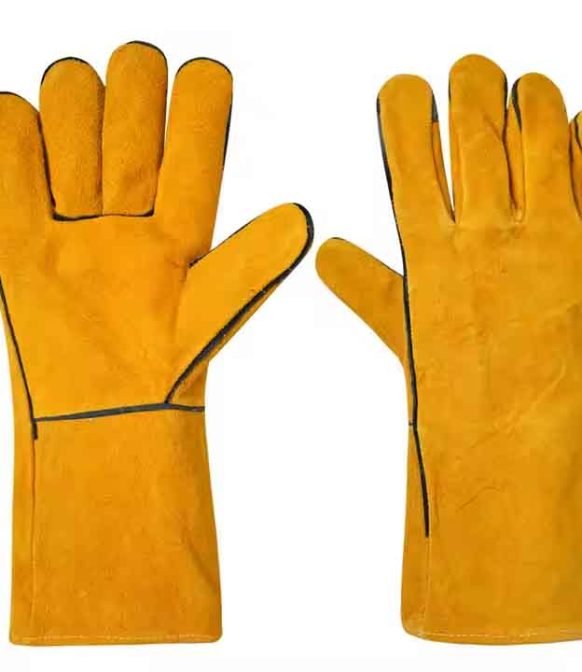
Cooperating Brands Trusted
Your product is produced in reliable leather factory like our already cooperating international brand partners below:
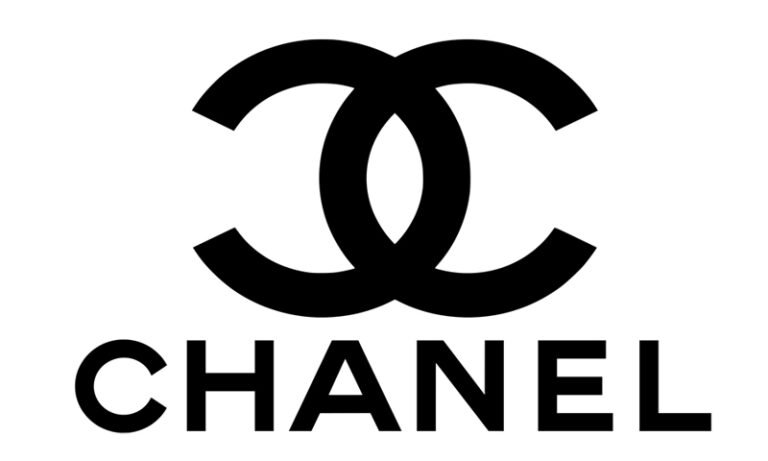


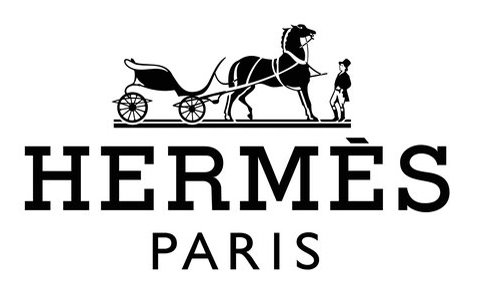

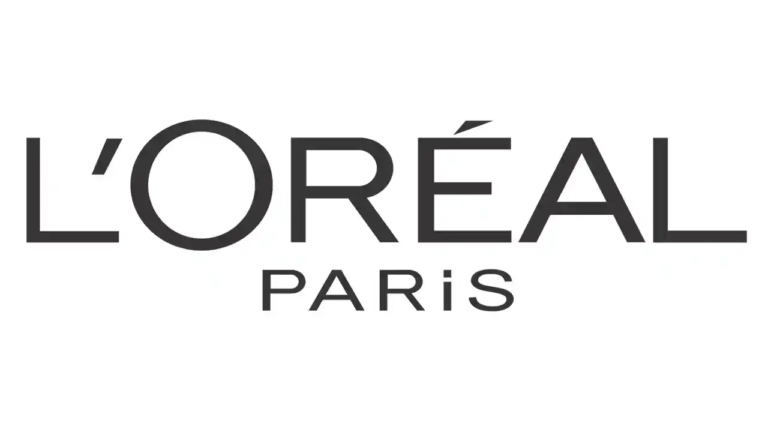





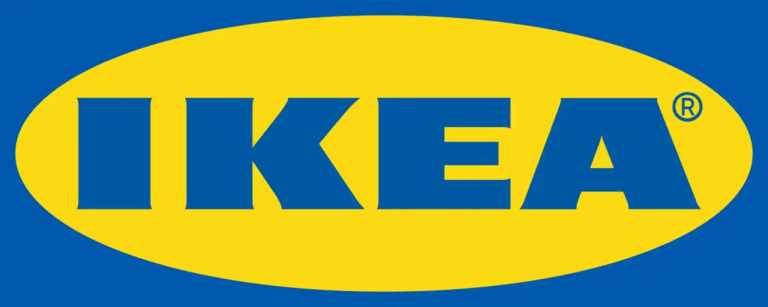
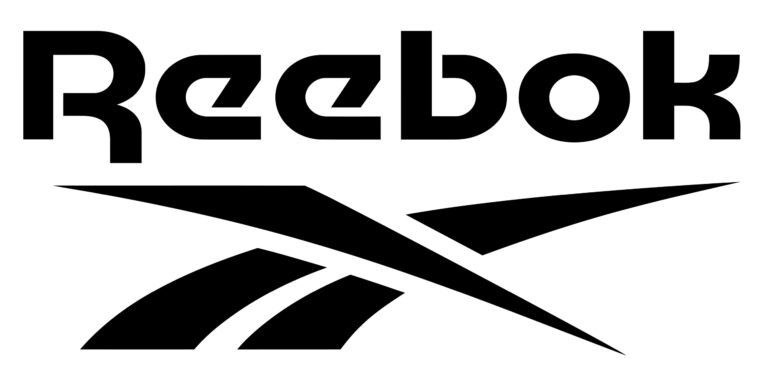
Effective Production Process
We believe quality is always the key to success, which includes a responsible approach to manufacturing, and controlling whole process.
Factory Direct Wholesale Leather Glove Styles – Ready to Ship
At Szoneier Leather, we offer a wide range of factory direct wholesale leather glove styles that are ready to ship, ensuring fast delivery for our clients. Our in-stock selection includes various types of leather gloves, including fashion gloves, work gloves, winter gloves, and driving gloves, all crafted from premium leathers like goatskin, sheepskin, and cowhide. With a strong, integrated supply chain, we maintain consistent inventory across multiple styles and sizes, enabling us to meet both small and bulk orders with quick turnaround times. We understand the urgency of fast shipping, and our efficient production process ensures that all orders are dispatched promptly, reducing lead times and accelerating your time to market. Each pair of gloves is crafted with high attention to detail, ensuring comfort, durability, and style. Whether you are a retailer, wholesaler, or brand looking to stock premium leather gloves, our ready-to-ship stock guarantees flexibility and reliability.

leather work gloves

leather winter gloves

leather touchscreen gloves

leather palm gloves

leather opera gloves

leather motorcycle gloves

Pigskin leather gloves

leather gardening gloves

leather driving gloves

leather bike gloves

ladies leather gloves

insulated leather gloves

Golf Leather glove

goatskin gloves

fingerless leather gloves

faux leather gloves

deerskin gloves

ski gloves leather

sheep skin gloves

mens leather gloves
The most commonly used leathers for gloves are:
Goatskin: Soft, durable, with natural lanolin; ideal for driving and fashion gloves.
Sheepskin: Extremely soft and lightweight; perfect for premium or winter gloves.
Cowhide: Thick, rugged, and long-lasting; widely used in work gloves.
Deerskin: Very soft and flexible, yet strong; often used in luxury gloves.
Pigskin: Durable and breathable with a grainy texture; used for work and sport gloves.
Over 70% of utility gloves use goatskin or cowhide due to their balance of flexibility and strength.
Consider the following criteria:
Usage scenario: Fashion, work, winter, or driving?
Target market: Entry-level (PU/pigskin) vs. premium (sheepskin/deerskin).
Style requirements: Full-finger, half-finger, lined, touchscreen-compatible?
Durability needs: Goatskin lasts 20–30% longer than sheepskin in heavy use.
Tip: For fashion gloves, sheepskin + cashmere lining is the best-seller combo in retail.
Custom leather gloves help:
Build brand identity through logos, custom colors, and unique designs.
Increase product value perception—embossed logos and exclusive linings add perceived luxury.
Improve customer loyalty with limited-edition glove runs.
Brands that offer seasonal glove customization see up to 35% repeat customer rate.
MOQ varies depending on customization level:
Standard logo embossing: 200 pairs
Pantone color custom leather: 300–500 pairs
Custom design (pattern + lining + logo): 500–1000 pairs
For stock gloves (ready-made), MOQ can be as low as 50–100 pairs per style.
Typical lead times are:
Sampling: 7–10 days
Mass production: 25–35 days for 1000–3000 pairs
Urgent orders: 15–20 days available with rush service
90% of repeat orders at Szoneier Leather are completed within 30 days.
Yes. We support:
Size range: XS to XXL
Styles: Full-finger, fingerless, touchscreen, winter-lined, utility, dress gloves
Gender: Men’s, women’s, and unisex patterns available
Over 60% of our clients mix 3–4 sizes per order to cover full retail demand.
Absolutely. We offer:
Reinforced stitching and padding
Abrasion-resistant cowhide and pigskin gloves
Water-resistant and insulated options for winter outdoor use
Our cowhide work gloves are tested to withstand over 8,000 cycles of flex without tearing.
We implement:
5-step quality control: Raw leather check → Cutting → Stitching → Logo & finishing → Final inspection
Colorfastness tests, seam strength tests, fit checks
AQL 2.5/4.0 standard for export gloves
Every pair is manually checked—over 15% of gloves are sampled for double QA before packaging.
We offer:
Logo methods: Embossed, debossed, embroidery, foil stamping, printed, rubber patch
Lining options: Wool, fleece, cashmere, Thinsulate
Hardware & details: Snap buttons, zippers, touchscreen tips
Colors: Free Pantone color matching
More than 150 brands have used our logo embossing on sheepskin and goatskin gloves.
Generally we customers make payment by 1.TT(electronic funds transfer) From All Countries ,2.Western Union,we may also accept small payment by 3.Paypal (4.Credit Card Accept) for sample order and,5. LC(letter of credit) for big order.6.Alibaba Trade Assurance. click to learn more payment information.
We support:
Air freight (5–7 days) for small to mid-sized orders
Sea freight (15–35 days) for bulk volumes
FOB, CIF, DDP terms available
In-stock glove styles can be shipped within 3 working days after payment.
Frequently Asked Questions
Welcome to the FAQs on branded personalized leather Gloves in bulk, where we address your common questions and provide insights on styles, features,and related matters, ensuring you make informed choices for your business.










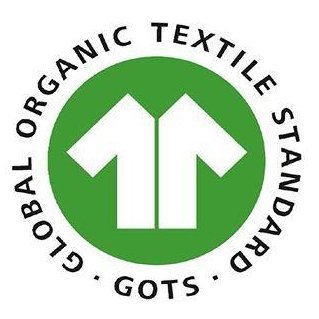
Personalized Leather Gloves – Fully Customizable Solutions by Szoneier Leather
At Szoneier Leather, we provide end-to-end personalized leather glove manufacturing services tailored to professional buyers, fashion brands, and wholesale clients worldwide. With years of experience and vertically integrated production, we help clients turn their glove concepts into high-quality, market-ready products with full control over every detail.
Why Choose Szoneier for Custom Leather Gloves?
Material Versatility & In-House Supply Chain
We offer a wide selection of materials including full grain cowhide, sheepskin, goatskin, deerskin, lambskin, pigskin, and PU/vegan leather, all sourced and processed through our own raw material channels. Each leather type is available in various textures (smooth, pebbled, nappa, distressed) and supports free Pantone color matching for precise brand alignment.Comprehensive Design Support
From initial sketch to CAD, our experienced design team supports you with custom glove patterning, ergonomic sizing, and technical detailing like lining selection (cashmere, fleece, wool, Thinsulate), touch-screen fingertips, wrist closures, and inner tag branding.Multiple Logo Application Options
We offer diverse branding solutions such as:Embossed / Debossed logos
Laser engraving
Screen or silicone printing
Embroidery on fabric-backed panels
Metal badges, rubber logos, or woven labels
These are tailored to match the glove’s surface type and target use (fashion, workwear, promotional, etc.).
Flexible Order Quantities & Fast Sampling
We support low MOQ starting at 200 pairs for standard styles, and 7–10 day sampling for custom designs. Mass production lead times typically range from 25–35 days, with rush options available.Strict Quality Assurance
All gloves pass through 6-stage quality inspection, including leather defect screening, stitching accuracy, logo precision, fit testing, and final packaging review. We follow AQL 2.5/4.0 inspection standards to ensure consistency and performance.
Whether you’re developing luxury leather gloves, launching a branded promotional collection, or building a seasonal fashion line, Szoneier Leather is your trusted factory partner. We combine craftsmanship, scalability, and customization to bring your glove designs to life—professionally and efficiently.
what are leather gloves used for?
Leather gloves are widely used across various industries and lifestyle segments due to their durability, flexibility, grip, and premium appearance. Their applications range from protective workwear to high-fashion accessories, making them a versatile product category for brands, retailers, and custom manufacturers. Below is a detailed guide of their main uses:
1. Industrial and Work Gloves
Leather gloves are essential in many labor-intensive industries where hand protection is critical.
- Construction & Engineering: Protects against abrasion, cuts, and impact.
- Welding & Metalwork: Heat-resistant leather (often cowhide or goatskin) is used to shield hands from sparks and hot surfaces.
- Agriculture & Landscaping: Provides grip and protects from thorns, tools, and rough surfaces.
- Mechanical Work: Durable enough for repeated use in automotive, maintenance, or heavy machinery tasks.
- Preferred Materials: Cowhide, goatskin, pigskin for abrasion resistance and flexibility.
2. Fashion & Everyday Wear
Leather gloves have long been a staple in seasonal fashion, offering elegance and function.
- Winter Fashion Gloves: Insulated with wool, cashmere, fleece, or Thinsulate to retain warmth.
- Driving Gloves: Improve grip on the wheel and reduce vibration while adding a stylish, vintage touch.
- Luxury Accessories: Made with lambskin, sheepskin, or Nappa leather for a soft, refined finish.
- Touchscreen Gloves: Integrate conductive fingertips for smartphone use without removing gloves.
3. Motorcycle & Biker Gloves
Used by riders for both protection and comfort.
- Functions: Reduce road vibration, improve grip, and protect hands in the event of falls.
- Features: Often reinforced with knuckle padding, anti-slip palms, and perforations for breathability.
- Preferred Leathers: Goatskin and cowhide for their balance of strength and flexibility.
4. Winter and Outdoor Sports
Leather gloves are ideal for cold climates and outdoor recreation.
- Activities: Skiing, snowboarding, hiking, and mountaineering.
- Key Features: Insulated, windproof, and often waterproofed.
- Materials Used: Deerhide or sheepskin with thermal linings for warmth and dexterity.
5. Uniform & Dress Gloves
Used by law enforcement, military, ceremonial guards, and corporate staff.
- Use Cases: Adds a formal, sharp appearance for parades, VIP events, or official duties.
- Features: Typically black or white, with a clean, polished finish.
- Material: Smooth cowhide, Nappa, or PU leather for uniformity and ease of cleaning.
6. Corporate & Promotional Gifts
Custom leather gloves are a popular premium giveaway item for brand promotions.
- Branding Options: Embossed logos, Pantone-matched colors, custom tags.
- Application: Ideal for automotive brands, outdoor gear companies, or luxury fashion lines.
- MOQ Flexibility: Small-batch production for limited-edition launches or holiday promotions.
Summary of Leather Glove Applications:
| Category | Key Use Cases | Common Leathers |
|---|---|---|
| Work Gloves | Construction, welding, gardening | Cowhide, goatskin |
| Fashion Gloves | Winter, driving, daily wear | Sheepskin, lambskin |
| Motorcycle Gloves | Riding protection, grip, vibration control | Cowhide, goatskin |
| Outdoor Gloves | Snow sports, hiking, winter safety | Deerskin, sheepskin |
| Dress/Uniform Gloves | Military, police, formal attire | Nappa, PU, smooth cowhide |
| Promotional Gloves | Corporate gifting, brand giveaways | PU, cowhide, lambskin |
Popular Types of Leather for Gloves: A Complete Guide
When selecting the ideal material for gloves, leather stands head and shoulders above most alternatives. Not only does it offer superior durability and protection, but it also provides flexibility, dexterity, and an unmistakable sense of timeless style. However, not all leathers are created equal. Different animal hides exhibit unique characteristics—ranging from softness and breathability to resistance against abrasion and cold—that directly influence a glove’s performance, lifespan, and feel. This guide delves into the most popular leathers used for glove manufacturing, exploring their properties, advantages, disadvantages, and best-use scenarios. Whether you’re shopping for rugged work gloves, luxury driving gloves, or weather-resistant winter mittens, understanding the nuances of each leather type will help you make an informed choice.
Key Performance Factors for Leather Gloves
Before examining specific leather types, it’s helpful to understand the attributes that make a leather suitable (or not) for glove construction. Most buyers evaluate leathers based on the following criteria:
- Durability & Abrasion Resistance
- How well the leather withstands daily wear, scrapes, and punctures.
- Critical for work gloves, motorcycling, and equestrian applications.
- Flexibility & Dexterity
- The degree to which the leather stretches and conforms to hand movement.
- Essential for tasks requiring fine motor skills (e.g., driving, shooting).
- Softness & Comfort
- Tactile feel against the skin, both initially and over time as the leather breaks in.
- Influences overall wearer comfort—important for dress gloves and casual use.
- Breathability & Moisture Wicking
- Ability to allow air circulation and wick away sweat.
- Impacts comfort during prolonged wear or in variable climates.
- Thermal Insulation & Weather Resistance
- The leather’s capacity to insulate against cold and repel moisture (e.g., rain, snow).
- Often enhanced via lining (e.g., fleece, Thinsulate) or treatments (e.g., waterproof coatings).
- Grip & Tactile Feedback
- Surface “grippiness,” particularly important for activities like driving or handling tools.
- A rougher grain can improve grip but may sacrifice initial softness.
- Aesthetic & Finish
- Natural grain patterns, available dye colors, and sheen.
- Luxury gloves often rely on fine‐grain, uniform hides for a sleek appearance.
- Cost & Availability
- Rarity of the hide and complexity of tanning processes influence price.
- Some exotic leathers (e.g., elkskin) are considerably more expensive than common cowhide.
Cowhide Leather
Cowhide is arguably the most common base leather for gloves—especially in work‐ and utility‐oriented designs. Its ubiquity stems from cattle’s worldwide availability, combined with a relatively large hide area (minimizing seams) and a balanced balance of toughness and flexibility. When correctly tanned, cowhide exhibits excellent resistance to abrasion, tears, and punctures.
Key Characteristics
- Durability: ★★★★★ (highest)
- Flexibility: ★★★☆☆ (moderate)
- Softness: ★★☆☆☆ (breaks in over time)
- Breathability: ★★★☆☆
- Thermal Properties: Average—often paired with linings for cold-weather gloves.
- Grip: Good—natural grain provides moderate traction.
Subtypes & Finishes
- Full-Grain Cowhide
- Retains the outermost layer of the hide (complete grain pattern).
- Maximum strength, puncture resistance, and abrasion resistance.
- Requires a break-in period before reaching optimal suppleness.
- Top-Grain Cowhide
- Slightly sanded or buffed to remove minor blemishes.
- More uniform appearance; marginally less robust than full‐grain.
- Softer feel out of the box and quicker tempo break-in.
- Split Cowhide (Suede)
- The hide’s inner layer, buffed to create a nap (soft, fuzzy surface).
- Less durable than full/top-grain; highly pliable and often used for fashion gloves.
- Lower abrasion resistance, but superior softness and lighter weight.
Typical Applications
- Heavy-Duty Work Gloves (Construction, Welding, Landscaping): Full-grain cowhide resists sparks, rough surfaces, and mechanical abrasion.
- Motorcycle & Rider Gloves: Top-grain cowhide balances protection with flexibility. Leather may be reinforced with Kevlar or hard-shell armor.
- Gardening & General Utility Gloves: Split cowhide gloves (suede) are lightweight, breathable, and offer reasonable protection at a lower price point.
Pros & Cons
- Pros:
- Exceptional abrasion and puncture resistance
- Inexpensive and widely available
- Easy to clean and condition
- Cons:
- Requires significant break-in for maximum dexterity
- Can feel stiff out of the box (especially full-grain)
- Not as soft or lightweight as some exotic leathers (e.g., deerskin)
Goatskin Leather
Goatskin is prized for its unique grain structure, which contains pronounced lanolin content. As a result, goatskin gloves often feel buttery soft from the outset, while still maintaining respectable durability. The fine pebble-like grain also helps wick moisture, improve grip, and provide natural water resistance.
Key Characteristics
- Durability: ★★★★☆ (very good)
- Flexibility: ★★★★☆ (very good)
- Softness: ★★★★☆ (notes of silkiness)
- Breathability: ★★★★☆
- Thermal Properties: Good—lanolin helps insulate and repel light moisture.
- Grip: Very good—natural grain and slight texture.
Subtypes & Finishes
- Nappa Goatskin
- Refers to vegetable-tanned, uncorrected grain; extremely soft.
- Common in high-end fashion or driving gloves.
- Chrome-Tanned Goatskin
- More colorfast; better stretch recovery and water resistance compared to vegetable tanned.
- Often used in winter glove linings (e.g., Thinsulate laminated to goatskin).
Typical Applications
- Dress & Driving Gloves: Smooth, flexible fit; excellent tactile feedback on steering wheels or fine tasks.
- Mechanics & Maintenance Gloves: Good balance of dexterity, durability, and grip; goatskin endures oil/mild chemicals better than sheep or lamb.
- Outdoor Cold-Weather Gloves: When combined with fleece or wool lining, goatskin’s natural lanolin aids in water resistance and insulation.
Pros & Cons
- Pros:
- Soft immediately—minimal break-in required
- Natural water and stain resistance (lanolin)
- Good tensile strength and abrasion resistance relative to thickness
- Cons:
- More expensive than cowhide or elk
- Not as resistant to extremes (very high heat or industrial chemicals)
- Pore structure makes it prone to discoloration if not properly conditioned
Sheepskin & Lambskin Leather
Sheepskin and lambskin are often lumped together, but there are slight differences. Sheepskin refers broadly to sheep hide (often a bit thicker), while lambskin is the hide specifically from younger sheep, leading to an ultra-soft, supple surface. These hides are primarily chosen for their luxurious hand feel, lightweight nature, and excellent insulating properties.
Key Characteristics
- Durability: ★★☆☆☆ (lower than cow or goatskin)
- Flexibility: ★★★★★ (highest)
- Softness: ★★★★★ (ultra-soft)
- Breathability: ★★★★☆
- Thermal Properties: Excellent—naturally insulating but not highly water-resistant.
- Grip: Moderate—very smooth, so often paired with textured palms in design.
Subtypes & Finishes
- Virgin Shearling (Sheepskin with Wool Pile)
- One side retains the wool fleece (ideal for cold-weather mittens), other side is leather.
- Exceptionally warm—used in UGG-style or aviator gloves.
- Refined Lambskin
- Thin, velvety, and highly uniform.
- Predominantly used in dress gloves, fashion gloves, and high-end driving gloves.
Typical Applications
- Luxury & Fashion Gloves: Lambskin’s unmatched softness, minimal grain, and uniform color make it a staple in couture designs.
- Cold-Weather & Winter Gloves: Shearling gloves (sheepskin with fleece) are commonly used in extreme cold for outdoor activities (aviation, skiing, casual winter wear).
- Light-Duty Casual Gloves: Thin unlined sheepskin gloves for mild weather or indoor tasks.
Pros & Cons
- Pros:
- Supreme softness and luxury feel
- Excellent insulating properties (especially shearling)
- Very lightweight—ideal for fine dexterity
- Cons:
- Poor abrasion resistance—prone to tearing under heavy use
- Minimal water resistance—absorbent if untreated
- Requires frequent conditioning to avoid drying and cracking
Deerskin Leather
Deerskin stands out thanks to its fine grain, buttery suppleness, and impressive tensile strength relative to its thinness. Deer hide possesses naturally porous fibers, giving it exceptional breathability and stretch. Over time it conforms uniquely to the wearer’s hand, delivering a personalized fit many glove aficionados prize.
Key Characteristics
- Durability: ★★★★☆ (very good for weight)
- Flexibility: ★★★★★ (highest)
- Softness: ★★★★☆ (soft with light “pebbled” texture)
- Breathability: ★★★★★ (excellent)
- Thermal Properties: Good—breathable but not waterproof without treatment.
- Grip: Excellent—fine grain offers natural tackiness.
Subtypes & Finishes
- Vegetable-Tanned Deerskin
- Traditional tanning yields earthy hues (tan, brown).
- Forms a rugged patina over time.
- Chrome-Tanned Deerskin
- More consistent coloring (often dyed) and flexible “break-in.”
- Better water resistance and stretch recovery.
Typical Applications
- Shooting & Hunting Gloves: Unmatched dexterity and tactile feedback when handling triggers; natural camouflage hues common.
- Motorcycle Liner Gloves: Used under hard-shell armor; thin enough for layering while still providing abrasion resistance.
- Luxury Driving & Casual Gloves: Fine grain and breathability make deerskin a top-choice for premium driving gloves.
Pros & Cons
- Pros:
- Supreme flexibility and break-in—“breaks in to the hand” more quickly than most leathers
- Outstanding breathability—reduces humidity buildup during extended wear
- Durable for its weight and easily cleaned
- Cons:
- More expensive and harder to source than cow or sheep
- Susceptible to stains unless treated (porous fiber structure)
- Not inherently waterproof—requires additional coatings for wet conditions
Pigskin Leather
Pigskin is an oft-overlooked yet practical leather for gloves. Its distinctive feature is an open pore structure (visible “pips” or freckles), which provides admirable breathability. Pighide is usually sourced from the underside of the pig, making it thinner than most cowhides yet tougher than sheepskin.
Key Characteristics
- Durability: ★★★☆☆ (moderate)
- Flexibility: ★★★☆☆ (moderate)
- Softness: ★★★☆☆ (initially firm, softens over time)
- Breathability: ★★★★★ (very high)
- Thermal Properties: Average—breathable but not warm in severe cold.
- Grip: Good—natural texture offers traction.
Subtypes & Finishes
- Split Pigskin Suede
- The flesh side of pig hide, buffed to a nap.
- Highly breathable and flexible but lower abrasion resistance.
- Full-Grain Pigskin
- Retains outer pattern; less common for gloves (more often used in upholstery).
Typical Applications
- Mechanics & Maintenance Gloves: Breathable option when hand perspiration is a concern.
- Automotive Work Gloves: Affordable, moderately protective, and very breathable for hot garages.
- Sports & Athletics Gloves: Baseball catcher’s mitts often incorporate pigskin panels for breathability.
Pros & Cons
- Pros:
- Exceptional moisture wicking—ideal in hotter, sweat-prone environments
- Inexpensive and easy to source
- Light mildew resistance due to open weave
- Cons:
- Fairly low abrasion resistance—easily wears through under heavy loads
- Needs time to break in for acceptable softness
- Not suitable for heavy-duty or cold-weather gloves
Elkskin & Bison Leather
Elkskin and bison leather belong to the “heavy-game” category of leathers—thick, robust, and ideal for extreme conditions. Though share similarities, elk hides tend to be slightly more supple than bison, which lean toward more pronounced grain patterns. These leathers are exceedingly durable, yet thinner elk hides can be surprisingly flexible.
Key Characteristics
- Durability: ★★★★★ (highest)
- Flexibility: ★★★☆☆ (elk: ★★★★☆, bison: ★★★☆☆)
- Softness: ★★★☆☆ (elk: ★★★★☆ with break-in, bison: ★★★☆☆)
- Breathability: ★★★☆☆
- Thermal Properties: Very good—thicker hides retain warmth.
- Grip: Good—pronounced grain enhances traction.
Subtypes & Finishes
- Full-Grain Elk Leather
- Slightly more pliable than bison; breaks in over time to a soft, comfortable hand.
- Best suited for heavy gloves where flexibility is still desired.
- Full-Grain Bison Leather
- Thick, chunky grain with a rustic appearance.
- Exceptional abrasion resistance but requires extended break-in before full dexterity.
Typical Applications
- Cold-Weather Outdoor Gloves (Skiing, Snowmobiling): Combined with insulated linings (Thinsulate, shearling), elk and bison provide maximum protection in sub-zero temperatures.
- Tactical & Hunting Gloves: High abrasion resistance against brush, rocks, and branches. Elk’s slightly thinner hides are preferred where dexterity is still critical.
- Heavy-Duty Work Gloves: Bison in welding or logging gloves where heat resistance and puncture defense are paramount.
Pros & Cons
- Pros:
- Unmatched abrasion and tear resistance—ideal for severe conditions
- Excellent insulating properties without added bulk
- Unique, rustic grain that ages to a distinguished patina
- Cons:
- Very rigid initially—extensive break-in required
- Heavier weight—not suited for fine motor tasks
- Among the most expensive leathers used in gloves
Synthetic vs. Natural Leather
While this guide focuses on traditional animal hides, it’s worth briefly mentioning synthetic leather (e.g., PU or microfiber “leathers”) as an alternative.
- Polyurethane (PU) Leather
- Often referred to as “vegan leather.”
- Cheaper, uniform appearance, easy to clean.
- Drawbacks: Poor breathability, inferior abrasion resistance, limited lifespan (peels/cracks).
- Microfiber Leather
- Made from ultra-fine synthetic fibers bonded to a polyurethane coating.
- Can outperform cowhide in abrasion tests and is often water resistant.
- Drawbacks: Less natural feel; some high-end users consider it “plasticky.”
- When to Choose Synthetic
- Budget Constraints: Price can be 50–75% lower than genuine leather.
- Vegan/Allergy Concerns: No animal products or lanolin; some synthetics may cause skin irritation over time.
- Consistent Aesthetic Needs: Uniform color and texture from batch to batch.
- Why Many Professionals Stick with Natural Leather
- Longevity: A high-quality leather glove can last 3–5× longer than its synthetic counterpart if cared for properly.
- Breathability & Comfort: Natural fibers wick moisture and regulate temperature far better than plastics.
- Age-Defying Patina: Leather acquires character with wear; synthetics simply degrade.
Comparative Table
Below is a side-by-side comparison of the most popular leathers used in glove manufacturing. Ratings are relative (★ being low, ★★★★★ being high) and assume proper tanning/treatment.
| Leather Type | Durability | Flexibility | Softness | Breathability | Water Resistance | Typical Applications |
|---|---|---|---|---|---|---|
| Cowhide | ★★★★★ | ★★★☆☆ | ★★☆☆☆ | ★★★☆☆ | ★★☆☆☆ | Work gloves, motorcycle gloves, gardening, utility |
| Goatskin | ★★★★☆ | ★★★★☆ | ★★★★☆ | ★★★★☆ | ★★★☆☆ | Dress/driving, mechanics, outdoor winter gloves |
| Lambskin/Sheepskin | ★★☆☆☆ | ★★★★★ | ★★★★★ | ★★★★☆ | ★☆☆☆☆ | Luxury fashion, driving gloves, shearling cold mittens |
| Deerskin | ★★★★☆ | ★★★★★ | ★★★★☆ | ★★★★★ | ★★☆☆☆ | Shooting/hunting, liner gloves, premium driving |
| Pigskin | ★★★☆☆ | ★★★☆☆ | ★★★☆☆ | ★★★★★ | ★★☆☆☆ | Mechanics, automotive, sports, light-duty work |
| Elkskin | ★★★★★ | ★★★★☆ | ★★★☆☆ | ★★★☆☆ | ★★★☆☆ | Cold-weather outdoor, tactical, heavy work |
| Bison | ★★★★★ | ★★★☆☆ | ★★★☆☆ | ★★★☆☆ | ★★★☆☆ | Extreme condition gloves, welding, logging, tactical |
| Microfiber (Synthetic) | ★★★★☆ | ★★★☆☆ | ★★★☆☆ | ★★☆☆☆ | ★★★★☆ | Affordable fashion, budget work gloves, vegan-friendly |
| PU (Synthetic) | ★★☆☆☆ | ★★☆☆☆ | ★★☆☆☆ | ★★☆☆☆ | ★★★★☆ | Basic casual gloves, costume, disposable applications |
Leather Glove Care & Maintenance
To maximize both performance and lifespan, proper care is essential—especially when investing in higher-end hides. Below are general best practices for leather glove maintenance:
- Regular Cleaning
- Light Dirt or Dust: Wipe gently with a soft, dry cloth.
- Grime or Stains: Use a slightly damp cloth with a mild, pH-neutral soap (e.g., glycerin saddle soap). Avoid saturating the leather—excess water can cause stiffness or mold. Wipe away soap residue, then let air dry at room temperature (avoid direct heat).
- Conditioning & Softening
- Frequency: Every 2–3 months for frequently worn gloves (or sooner if dry/cracked).
- Products: Apply a thin layer of leather conditioner (animal-based or silicone-free) using a lint-free cloth or sponge. Focus on areas that flex (knuckles, palm). For goatskin and deerskin, choose a conditioner designed specifically for fine grained hides to avoid clogging pores.
- Waterproofing Treatments
- Waxed Canvas/Leather Coatings: Use beeswax or specialized sprays for additional water resistance. Reapply monthly during wet seasons.
- Avoid Over-Tanning: Overly heavy treatments can reduce breathability and make leather stiff.
- Storage
- Dry, Well-Ventilated Area: Humidity levels between 40–60% are ideal.
- Avoid Plastic Bags: They trap moisture, leading to mildew. Use breathable fabric pouches or hangers.
- Maintain Shape: Stuff lightly with acid-free tissue paper to preserve form (especially for dress gloves).
- Break-In Tips
- For stiffer hides (cowhide, bison), wear gloves during light at-home tasks (short trips, driving).
- Gently “knead” gloves with your hands before putting them on—this pre-stretches fibers.
Ready To Elevate Your Leather products Line?
Join our global network of partners from 86 countries who have successfully collaborated with Szoneier. We welcome more customers to partner with us and experience our high quality leather goods solutions.

